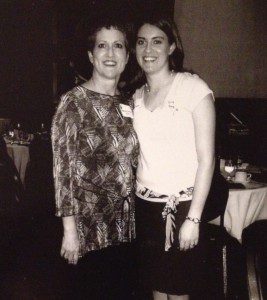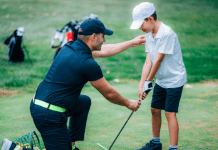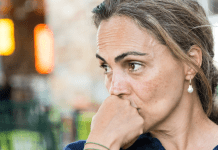
Breast cancer awareness once felt to me like a hazy, distant idea.
Then, my own mom was diagnosed with breast cancer. In just one day, breast cancer became a part of our family – taking unwelcome residence right in our living room.
When I came home from college on Mother’s Day that same year, I found my mom sitting on the couch and losing huge chunks of her hair. When I came home from a wedding rehearsal that summer, I heard her throwing up in the bathroom after a particularly bad chemo session. When I accompanied her to doctor appointments and chemo treatments, I met many patients like her – moms, wives, daughters and friends – who were weathering their diagnoses with grace and dignity.
In these moments, I felt all too aware of breast cancer.
October is Breast Cancer Awareness Month, and although my mom has thankfully been cancer-free for 10 years, I think often about this disease and the way it will forever be tied to our family’s story. Since breast cancer affects 1 in 8 women, it’s likely we each have been, or will somehow be, affected. (Breast cancer also affects men, though at a much lower rate of 1 in 1,000.)
Although we hear often about breast cancer awareness, it can still be difficult to know what this means. Here are a few concrete ideas about how we might all practice breast cancer awareness this month.
Breast cancer awareness may look like …
… educating ourselves and others about the risk factors for breast cancer and the importance of regular self-exams, clinical exams, and timely mammograms. According to St. Luke’s website,
- self-exams should happen monthly.
- clinical exams should occur at least every three years from ages 20 to 40, and yearly after age 40.
- annual mammograms should begin at age 40 unless you have a family history of breast cancer – in which case, your doctor will likely recommend these sooner.
… admitting that, if we’re honest, some of us don’t do regular self-exams because we’re afraid we might find something (which has often been my own excuse). Then, it means doing them, anyway, because early detection saves lives.
… realizing that breast cancer affects not only moms and grandmas, but also their children — even their adult children. Maybe awareness means loving and caring for such children as you would your own.
… offering to clean the house or bake a meal for a woman who is going through treatment.
… asking to hear the stories of those who have been affected by breast cancer or have lost someone to the disease, and genuinely caring about their experiences. As a survivor or patient, it might mean telling your story for the sake of others’ awareness.
… moving past stigmas and judgments about words like “cancer,” and also about things like baldness, mastectomies, or wigs.
… trying on fun wigs with your friend or showing up at her appointment so she doesn’t have to go alone.
… understanding that patients and their families may feel strange asking for help, or that they may even refuse your help (possibly because they are trying to operate with as much normalcy as possible). In such cases, give space, but still let them know you are thinking about them. Send a card, a gift card, or some tickets to a favorite activity.
… grieving with a fellow mom who has been diagnosed, realizing that breast cancer affects parts of her body that may feel closely tied to her motherhood – breasts that nursed or comforted babies, hair that was pulled by sticky fingers, or a strong stomach that cared for flu-ridden children but is now churned by medication.
… knowing that even survivors always live with the fear that the cancer could return. Every appointment can be difficult, and every milestone is a victory to be celebrated.
… actively celebrating that womanhood is not about unscarred breast tissue, good health, beautiful hair, or numbers on a scale. Womanhood is defined by none of these things, nor is a woman with breast cancer defined by her diagnosis.
Finally, awareness may look like supporting breast cancer organizations that are engaged in research or helping patients. There are many such national organizations you can support, and several of them have local chapters (such as Making Strides – Kansas City or the Young Survival Coalition – Overland Park).
Other local breast cancer resources include:
Breast Cancer Center at the University of Kansas Cancer Center
Breast Cancer Center at Sarah Cannon at Research Medical Hospital
Missy’s Boutique at the Richard and Annette Bloch Cancer Care Pavilion (provides scarves, hats, bra and wig fitting services, and more)
Courage Kits (provides care packages to women in the KC area who have been diagnosed with cancer)
In honor of Breast Cancer Awareness Month, we will be posting additional resources and stories from Kansas City moms throughout the month of October. If you know of great resources or have a story you’d like to share, we’d love to hear from you! Leave a comment below or connect with us on our Facebook page.

















Thanks for sharing your story. Love you and your mama. It’s hit pretty deep when you said,”it went from a distant idea to a part of your family”. I can’t imagine how hard the journey was. Thankful your mom is a survivor. I’ll never forget when she dyed part of her short hair blue in honor of the salt hawks!